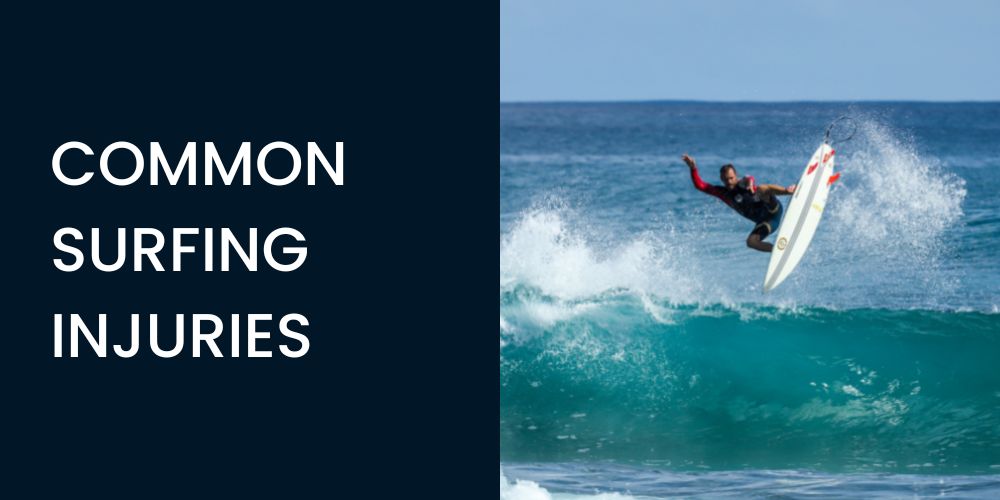The most common surfing injuries include reef cuts, surf rash, fin cuts, collisions with other surfers and surfboards and run-ins with dangerous marine life. For the most part, surfing is a safe sport and serious injuries are thankfully rare.
With that being said it’s always great to be aware of the potential consequences of going out and catching waves.
Let’s take a closer look at some of surfing’s most common injuries so you know what to try and avoid next time you’re in the ocean.
Reef cuts
As you start to progress at surfing you’ll want to move on from beachies to surfing reef break waves.
They typically provide much more mechanical setups and make getting barreled a lot easier. But there’s a price.
Hitting the ocean floor as you get washing machined across the reef is a thoroughly unpleasant experience. Hit the reef hard enough and you can be left with nasty cuts and grazes.
Surf rash
Most surfers will have gotten a rash from surfing at some point. Whether it’s your wetsuit, your board or your boardshorts.
Surf rash isn’t a massive deal and it is easily treatable with the application of some sort of lubricant between the issue area and your rash.
You can also consider using a good-quality rash vest underneath your suit as another layer of protection from unwanted rubbing.
Fin cuts and board collisions
With surfing getting more popular every year, lineups are very quickly getting crowded.
More people in the water means more accidental collisions and mishaps. This happens on all ends of the scale from amateurs and seasoned pros.
Getting hit by a board can vary in severity from a light bruise to full-blown unconsciousness and concussion.
Fin cuts are always nasty. Because of the force needed to cut through the skin (and sometimes wetsuit), fin cuts are normally quite severe.
Worse yet it’s not normally surrounded by bruising from the impact making for a seriously painful surfing injury.
Sea Urchins


When it comes to surfing pain these little spiky balls sent from hell are up there and can leave even the sturdiest of surfers grimacing.
Sea urchins are spiny, round marine animals that look like a cross between a hedgehog and a starfish. They have long, thin spikes that they use to protect themselves from predators.
You’ll normally find them tucked in small holes and crevices on rock or coral reefs just waiting for the bottom of your unsuspecting foot.
When the spikes puncture your skin you’ll feel a sharp stabbing pain of varying severity based on what kind of urchin you’ve had the pleasure of stepping on.
Needless to say, you’ll have to remove any remaining spines back on land and with some varieties being highly poisonous this can be a pretty serious issue.
Surfing injuries don’t normally come from marine life but the sea urchin dishes out some serious damage to surfer’s feet on reefs all over the world.
ACL
An anterior cruciate ligament (ACL) tear occurs when the ACL in your knee is damaged. The ACL connects your thighbone to your shinbone and helps stabilize your knee joint.
Most ACL injuries happen during sudden changes in direction which makes up the foundations of high-performance surfing.
Surfing and ACL tears are serious, recovery can be long-winded and surgery is often required. Pro surfers John John Florence and Mick Fanning have both had to overcome ACL injuries throughout their careers.
Wrist injuries
Wrist injuries are common among surfers. Not the first surfing injuries you’d think of but they can keep you out of the water for longer than you’d think.
It can happen when you fall directly onto your board or when you hit the reef after a shallow wipeout.
These injuries range from minor sprains to more serious breaks, dislocations and even joint fractures that can make it difficult/impossible for you to hold onto your surfboard.
Surfers knee
As you get better at surfing and start to surf on a regular basis some repetitive strain injuries can start to show their ugly head.
Surfers’ knee is an irritation or inflammation in the cartilage of the kneecap. It’s caused by overuse and excessive strain on the knees in line with surfing big powerful waves.
Symptoms include pain, swelling and restricted movement of the knee. Surgery may be necessary to repair the damage, but a recovery period can still take several months to a year depending on severity.
Meniscus tears
I’ve been the unfortunate owner of a torn meniscus and the time out of the ocean is what drove me to start this surf blog.
At the time of writing, I’m still waiting on surgery which could lead to 6 months of recovery before surfing at full capacity.
Head over to my article on surfing and meniscus injuries to find out how it happened and what you can do if you’ve been unfortunate enough to do the same.
Conclusion
Just remember, surfing isn’t all broken bones and blood. For the most part, it’s a safe enjoyable way to spend time in the ocean.
Surfing injuries are an unfortunate part of life but now you know what to look out for and try and avoid.
If you’ve enjoyed this read head over to one of the other short reads below for more interesting takes on the surfing lifestyle.

